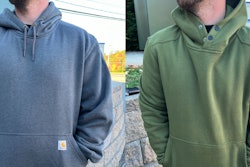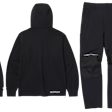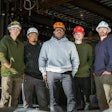
Choosing a construction jacket encompasses a variety of factors, including safety, durability, comfort, protection from the weather, mobility, and a proper fit.
The optimal construction jacket choice will check off all the boxes.
Safety always is the primary consideration with the choice of a construction jacket. The jacket should meet relevant safety regulations and standards – a company’s safety manager can help determine that it does.
A job task may require high-visibility features on a jacket. It may need to be a fluorescent color with reflective stripes, essential for low-light conditions and working around vehicular traffic and heavy machinery. This IRONPROS story delves into more detail on the different types and classes of high visibility jackets and under what working conditions each is worn. Some jobs may call for the worker to wear a fire-resistant jacket. Another consideration is the need for the jacket to offer protection from sparks and debris.
A draw-cord hood also helps provide comfort. Workers wearing a hard hat with a hooded jacket should ensure the hard hat straps and suspension system are adjusted to accommodate the extra layers of the hood and still provide a snug and secure fit.
A hood also may impair the ability to hear sounds clearly, obstruct peripheral vision or restrict head movements. A three-piece hood design may offer a better fit and peripheral vision. A detachable hoodie also may address any issues. Jackets with a removable hood, detachable storm flap and adjustable cuffs add more comfort options.
Durability also is an important factor for a construction work jacket. Durability is attainable through abrasion-resistant fabric and reinforced seams and stress point on the jacket. Ripstop fabrics also help ensure a jacket can withstand tough working tasks. Durability can be further protected by proper laundering of the jacket.
This IRONPROS story offers more details on how often to wash a work jacket. Follow the manufacturer’s instructions for the optimal outcome.
The weather protection a jacket provides ties into durability. Depending on the prevailing weather conditions, a construction jacket should offer waterproof or water-resistant qualities as well as wind-resistant components.
This IRONPROS story outlines considerations for waterproof fabrics. Water-resistant apparel repels water to a certain degree, but may not be entirely waterproof. Waterproof apparel is designed to keep water out entirely. Many waterproof materials also are windproof.
Waterproof apparel can be manufactured from synthetic materials such as polyester or nylon or natural materials such as rubber or waxed cotton.
Waterproof materials include polyester, nylon, and rubber. GORE-TEX is a membrane often used to make waterproof clothing. It is a breathable material that allows sweat to evaporate.
Manufacturers typically describe the waterproof and breathability ratings of fabrics using two numbers, often separated by a backslash. The first number is the waterproof rating. The second is breathability, with higher numbers indicating higher breathability.
If a construction jacket isn’t designed to be waterproof, a spray can be used to waterproof it as noted in this IRONPROS story. If the jacket has a DWR (Durable Water Repellent) rating, additional waterproofing may not be necessary.
Waterproofing product options on the market include wax-based solutions, sprays, and wash-in solutions.
Working at one’s optimal ability requires a jacket that provides comfort. Insulation is the key to warmth, depending on the weather conditions. The fabric should enable breathability to prevent overheating.
This IRONPROS story examines when wool is the best material for insulated construction jackets. This story looks at the benefits of polyester.
The mobility factor also is important and is a key to safety when moving about. The jacket’s ergonomics should allow a full range of motion and not be too tight or too loose. Stretch panels are one factor that helps to provide mobility.
Storage options designed into the jacket through pockets that enable a worker to store tools, a cell phone and other essentials are a plus. Some pockets have features such as hook-and-loop secure closure flaps to help keep items secure. Some jackets have pockets on the inside as well.
As for proper fit, construction workers will find more brands accommodating their needs – including that of women workers – thanks to OSHA’s proposed proper fit ruling that states that clothing must fit properly to protect workers from hazards.















